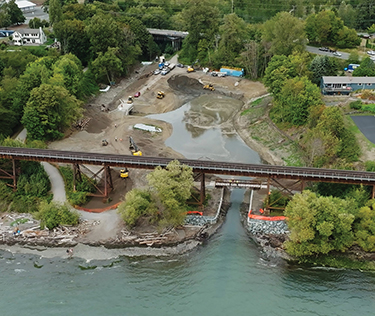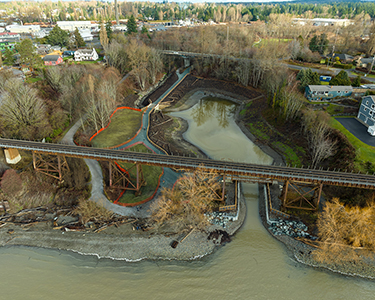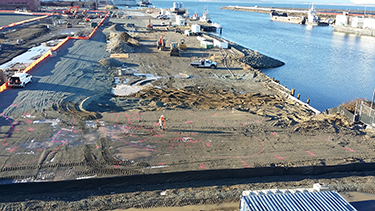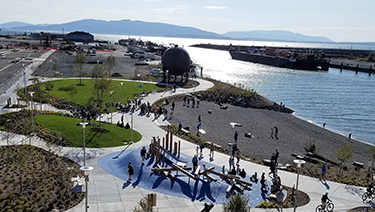|
Subscribe / Renew |
|
|
Contact Us |
|
| ► Subscribe to our Free Weekly Newsletter | |
| home | Welcome, sign in or click here to subscribe. | login |
Construction
| |
 |
March 28, 2024
Reclaiming our shores
Natural Systems Design + Coastal Geologic Services
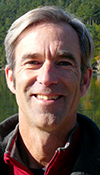
Johannessen
|

Chen
|
An 18-second video posted on the city of Bellingham’s YouTube channel last September helps summarize ongoing efforts to restore the natural functions and benefits of the Puget Sound shoreline. The time-lapse video shows water pouring from Bellingham Bay into the new Little Squalicum Estuary, with the caption “It’s not every day that you get to see water entering an estuary for the first time!”
The historic Little Squalicum Estuary project illustrates how government agencies, non-profit organizations and private businesses are joining together to recapture the ecological, societal and economic value of our treasured shores. It illustrates how investment in Puget Sound coastal restoration aids the recovery of endangered salmon populations, cleans abandoned industrial sites, restores natural coastal habitats and ecosystems, expands parks and recreational opportunities, and addresses the effects of sea level rise and climate change.
Regaining all that the Puget Sound coastal areas have lost is a daunting challenge. According to the Puget Sound Institute at the University of Washington, the Sound has lost nearly 400 miles of natural shoreline in the past 150 years. The Puget Sound Partnership, which tracks the health of the area’s ecosystem, said in its 2023 State of the Sound report, “Puget Sound is not doing well, but we see signs of progress.” Achieving this progress requires that we overcome a variety of obstacles, but the myriad benefits of the effort — including those highlighted below — are worth the fight.
COASTAL RESTORATION FOR SALMON RECOVERY
“As keystone species, salmon support diverse food chains, bringing nutrients from the ocean to rivers and streams,” the Washington Salmon Recovery Office notes. “Scientists estimate 138 species of wildlife, from whales to insects, depend on salmon for their food. Even trees and shrubs use salmon as fertilizer.”
Until the past few decades, salmon recovery efforts focused largely on inland rivers and streams. Further study showed the value of coastal restoration to the lifecycle of salmon, including estuaries, which are areas where fresh water mixes with saltwater. Coastal restoration efforts foster salmon population recovery through increased access for fish, refuge from predators, more forage fish spawning beach areas, and greater shade and temperature regulation.
As an example, the Little Squalicum Estuary project removed a fish passage barrier at the mouth of Little Squalicum Creek, created a 2.4-acre estuary, and reused excavated material as beach nourishment to enhance documented, but degraded forage fish spawning habitat to the northwest. Projects such as this require a deep understanding of geological and coastal processes, as well as the integration of applied coastal engineering to maximize ecosystem and public benefits, while creating self-sustaining projects.
RESTORE FAILING INFRASTRUCTURE AREAS
Shoreline infrastructure includes coastal roads, shore protection structures, docks, piers and other related structures. When still in use, this infrastructure supports coastal communities and maritime industries. We have many underutilized coastal properties, however, so restoration and redevelopment efforts in Puget Sound incorporate strategies to enhance infrastructure resilience while minimizing environmental impact.
On the Waypoint Park Beach project in the old GP mill site in Bellingham, our engineering team removed 156 feet of creosote-treated wood bulkhead and associated fill to improve the nearshore conditions. This not only helped create a more natural beach, it removed wood treated with chemicals and contaminated soil to prevent further marine water contamination. Removing the bulkhead and plantings enriched coastal habitat by allowing the exchange of terrestrial and aquatic nutrients, invertebrates, and organic material that were otherwise restricted by the armor structure and lack of vegetation.
A similar project is the 2020 Sucia Island State Park causeway road removal project, which reestablished full tidal exchange and fish passage into a large saltmarsh wetland. As with the Little Squalicum Estuary project, understanding the dynamic nature of the saltmarsh ecosystem and the morphological processes of the tidal inlet at Sucia Island was essential. These projects employed analysis tools with Sound-wide site data that led to the successful design and implementation of self-sustaining systems.
EXPAND PARK AND RECREATIONAL ACCESS
The Waypoint Park Beach and Little Squalicum Estuary projects illustrate how coastal restoration projects can improve access to recreational opportunities. Waypoint Park Beach, completed in 2018, restored a long-contaminated portion of downtown Bellingham’s Waterfront District in a way that connected the public to the water, while also benefiting fish and bird species.
A major component of the Little Squalicum Estuary project was enhancing access and safety at the extremely popular Little Squalicum Park. Project elements included installation of a new trail network, construction of a pedestrian bridge at the estuary mouth, and the planting of 4,500 native plants by volunteers hosted at a community event by the city of Bellingham and the Nooksack Salmon Enhancement Association.
The NSD + CGS team is also assisting the city of Bellingham on park improvements in Boulevard Park and creating new South Beach at Salish Landing Park at the old landfill, both of which involve debris removal and new beach creation.
ADDRESS SEA LEVEL RISE & CLIMATE CHANGE
Accelerating sea level rise and climate change exacerbate the already difficult task of restoring Puget Sound shores. For this reason, all shoreline restoration initiatives must fully consider and account for the changing conditions we expect in coming years. Planning and designing for climate change is crucial in maintaining the function of shoreline projects and infrastructure, as well as avoiding the potential for costly repairs and replacement later.
The Waypoint Park Beach project accommodated the projected 2.4-foot sea level rise by the year 2100 by adding three to five feet to its elevation. Our engineering team used gravel, sand and access structures to shape a beach to meet the uplands park area. At the larger new beach in the coming Salish Landing Park, we planned for over four feet of sea level rise to better ensure that we contain contaminants.
Coordination is key. The path to efficient and effective coastal restoration in Puget Sound is through a coordinated, multifaceted approach. Coastal ecosystem recovery and habitat restoration efforts are futile without addressing the impacts of sea level rise and climate change. We must keep this in mind as we collectively continue our efforts to preserve the beauty of Puget Sound, while regaining the immense ecological, social and economic benefits that its shores offer.
Jim Johannessen is a licensed engineering geologist and principal coastal geologist for Natural Systems Design + Coastal Geologic Services. Wei Chen is a licensed engineer and principal coastal engineer for Natural Systems Design + Coastal Geologic Services.
Other Stories:
- Centering equity, reconciliation and community in coastal adaptation
- Eastside cities partner for climate action
- Five environmental factors influencing construction in 2024
- Buried treasure: harnessing waste heat for a cleaner future
- Floating wetlands strengthen urban ecosystems and community engagement
- A park for all people — and the environment
- Planning for a rainy day, every day



